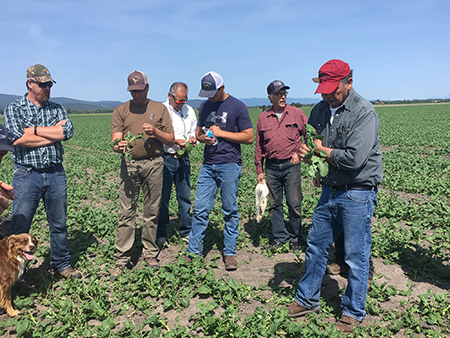Daily Dicamba Update: Q&A with Amy Asmus (Part 1)
CropLife had the chance to catch up with Amy Asmus, Owner/agronomist at Asmus Farm Supply based in Rake, IA, on her experiences with new dicamba-tolerant technologies – and why we can’t always accept the “no harm, no foul” attitude towards yields and drift. For part two of our conversation, be sure to catch tomorrow’s edition of the Daily Dicamba Update.
CL: Can you tell us about your region and how significant your dicamba sales were last year?
We are in four states: Iowa, Minnesota, Nebraska, and South Dakota are our main regions, but Iowa and Minnesota make up probably 90% of our sales, and it’s 50/50 between Iowa and Minnesota. Our growers that we advise mostly self-apply their product and we do not provide custom application. So most of my comments are based on grower application.
About 30% of our soybeans were the new dicamba technologies last year. Not all of the seed that was sold with the trait got dicamba over the top. What we saw last year is, people would buy the seed and then not necessarily plan for the dicamba. Then when it got to in-season, we had more people spraying dicamba on the trait than had originally planned to do so – around 60 to 65%, up from the 50% that originally planned the application. That just means that it moved to an in-season decision instead of a planned program, which is OK, because they were scouting and seeing what weeds are out there.
What we need to watch out for is that growers are not seeing it as a rescue treatment, because to be effective it needs to be a planned treatment, and you have to make sure you have the right weed height. If it’s seen as a rescue treatment, then we really have to watch the timing on that and the size of the weeds. If it’s a rescue treatment there are probably weeds out there that escaped earlier treatments and are much taller than the 4-inch limit.
CL: Did you hear about drift issues in your region last year?
Oh yeah. We didn’t do the numbers to find out what percentage of our customers had complaints. If I would try to guess, I would guess on the high side, because when you’re in the middle of the battle and everybody’s complaining it seems like everybody is complaining, but they’re not. We did have off-target movement, and we saw some weird off-target movement that we’ve never seen before in any of the other dicambas.
We spray (older forms of) dicamba in corn all the time. We have to understand when we’re spraying beans that there’s no barrier, whereas when you spray it in corn, it tends to be taller and there are more barriers. Beans are super-sensitive to dicamba. I always laugh about this with grapes. You can open a jug of 2,4-D and say, ‘2,4-D,’ and the grapes wilt. Soybeans are somewhat the same way with dicamba. Open a jug in the field and you’ll probably see symptoms without even applying it.
When everybody is on heightened alert, the EPA is looking at drift, people are looking for it. With all the hype around the fact that it could drift, we got way more complaints than if it had been used (in normal circumstances). They would have said, ‘We’ve got symptoms here but that’s dicamba; it’s not going to hurt the beans.’
So, some of the complaints were due to the heightened alerts around drift. We had people on the other side of it that said, ‘We’ve got some symptoms but it didn’t hurt my yield. I’m not going to turn you in, but be more careful next year.’ It will be interesting to see year-over-year how many people tolerated it the first learning year that won’t tolerate it next year.
CL: So you basically had two different camps?
Yes, there are two sides: Some people went to zero-tolerance because of the hype made about drift, and so they were looking for it. Some people were on the total opposite end of this thing, and said, ‘We understand it drifted. Now you’ve seen it a year – do a better job next year.’ It’s just all over the place. We have people that swear by it and we have people that won’t use it, just because of fear of off-target movement.
CL: How much were yields affected by those that saw drift?
For early drift, yields were not hardly affected at all. We had other people that said they saw a 10-bushel loss, if it was later. We didn’t see anything that was really devastated by drift, but I know the later applications hit it harder.
At one of our locations by Estherville, IA, we have a pocket of organic farmers. We talk about ‘no harm, no foul,’ because there was no yield reduction, but when you get into areas where they’ve got an organic certification and there are symptoms, that puts their organic certification in jeopardy, and they could lose their certification for three years or more. They may not have seen a reduction in their yields, but they just lost three years of organic certification because of somebody else’s (drift). So that is big foul.
The whole ‘no harm, no foul’ attitude really needs to be looked at, because I heard in the trainings, the companies saying, ‘Well, there was no yield reduction so it was no big deal.’ It’s a big deal to some growers.
CL: Can you speak more about how the loss of organic certification came about?
I heard (about the case) from my Estherville location. But to be a certified organic grower, you cannot have any pesticides that are not certified organic applied to your field. The symptoms proved there was some pesticide in field, whether you applied it or not. The fear growers have then is, ‘I’m not organic.’ You have to be free of pesticides that are not labeled as organic pesticides for three years before you can be certified organic. You have to know your neighbor and know your neighbor’s crop.
Read more on the label requirements here:
Get top-of-mind reminders on the new compliance and regulatory rules on dicamba directly to your email inbox. Subscribe to CropLife’s Daily Dicamba Update.







